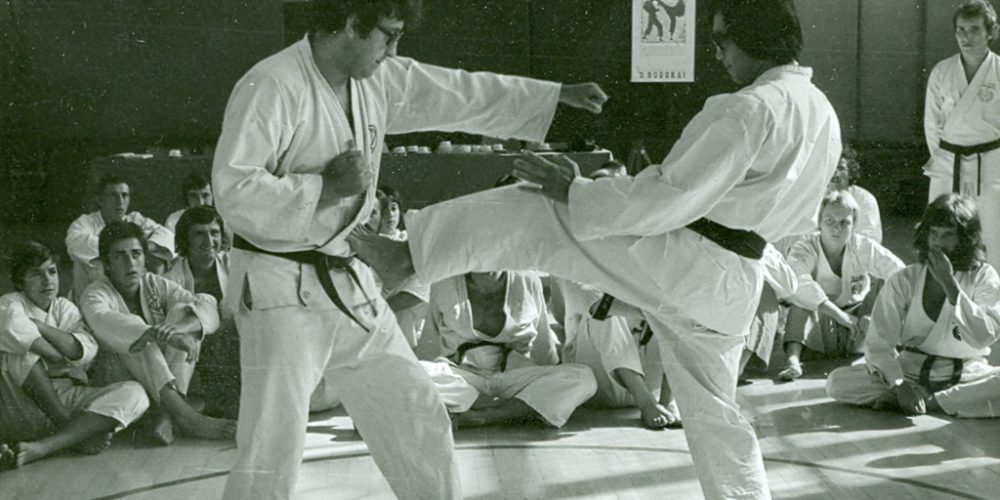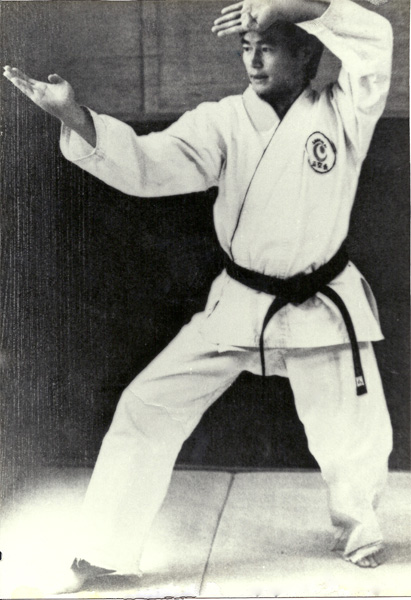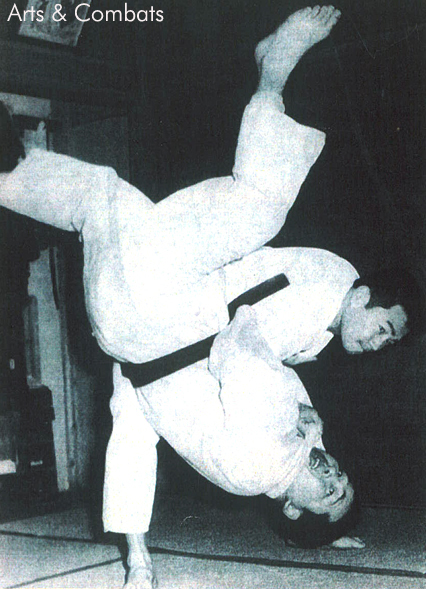Sankukai
Sankukai is often referred as a Shitoryu based style of Karate. This is the first style founded by Yoshinao Nanbu, at that point still very young Karateka. During the 1970s Sankukai was still a young, fast flowing style, aware of its traditional roots in both Nahate and Shurite. However, it incorporated modern thinking through Shukokai, Chojiro Tani’s system of scientific analysis and development of speed and power in technique, along with his expertise in aikido, judo, and traditional weaponry. Chojiro Tani, the creator of Tani-ha Shitoryu Shukokai, which became a branch of Shitoryu. Tani trained under Kenwa Mabuni, who created Shitoryu by combining some techniques from Gojuryu. Shukokai’s and later Sankukai’s parenthood, therefore, came from Shitoryu and Gojuryu. The two main features that typified Sankukai and differentiated it from other styles of Karate were: its emphasis on evasion techniques (tenshin) and circular movements (kaiten). These were represented on the Nanbu’s Sankukai emblem with three circles (Sun, Moon, Earth) aligned at an angle of 45 degrees, the typical angle of this style of Karate evasion. While other styles employed movement techniques (tai sabaki) and spinning attacks, Sankukai differs in formalising these as basics, which can be seen in the execution of randori no kata (pre-arranged pair work). The Sankukai equivalent of Pinan kata, known as Heiwa kata were adapted to incorporate, both, evasion and circular techniques.

At the heart of Sankukai were randori no kata, a set of routines for two Karateka with pre-arranged attacks and defences. Most of them had the same sequence of attacks with varying defences and counter attacks, e.g., the first one included counter attacks using punches, second one had counter attacks using kicks, third one made use of foot sweeps and take downs, fourth one employed wrist locks and throws, fifth one was all about weaponry. Kaiten randori no kata, first, second and third, employed the same principle now set into rotation. These concepts were carried further in ninangake, saningage, etc. In ninangake, e.g., there are two attackers who alternate their attacks following the same attacks as in randori no kata.
Kata was central to Sankukai, just as it is to most other styles of Karate. Basic shihozuki and taikyoku kata (also known as junino kata, relying on Shitoryu) were taught and are standard to most Shitoryu based systems. The Sankukai equivalent to these were the shihouke kata. These are known as Sanku kata when practiced with two attackers. They utilise tenshin, different blocks, and circular techniques, as, e.g., practiced in kaiten tsuki no kata and kaiten geri no kata. Sankukai equivalent of the Pinan kata (or Heian kata) are the Heiwa kata. These are rather more difficult to learn than Pinan due to the spinning techniques and evasive blocks. The only two katas on the syllabus that were exclusively Sankukai were shinsei (derived from gekkisai dai ichi) and tajima. Therefore, tajima was an important kata in the style and had to be performed by those attempting to pass their shodan. The other major katas demonstrate Sankukai’s heritage of both Nahate and Shurite systems. Many of these katas date back to the nineteenth century and some much older, e.g., matsukaze, jiin, kosokun dai, annanko, kururunfa (hyakuhachi), seipai, bassai dai, etc.
Nanbu broke with tradition in 1966 and became the first Japanese Karateka to participate in a European competition, risking the then reputation of the unassailable Japanese Karateka. He entered the French open national Cannes Cup. After sweeping his way through the opposition he met Patrick Baroux in the final. Baroux later became European champion of 1966 and 1967. The outcome of the fight was immortalised on the cover of Henri Plee’s book “Karate – Beginner to Black Belt” (1967). Baroux lies at the victor’s feet, defeated by Nanbu’s ashi barai. Another renowned Karateka that Nanbu beat on his way to the final was Dominique Valera. Years later in 1991, Valera was asked during an interview in “Fighting Arts International” for his memories of fighting Nanbu. Valera stated, “he was the first Japanese who succeeded in impressing me with his training – the first. I haven’t seen any others since the who impressed me in the same way, because Nanbu was a real fighter, yes a real fighter”. Towards the end of 1966, Nanbu returned to Japan to study Shukokai, the new system being formed by Tani, with Shigeru Kimura. He came back to Europe briefly in 1967 and at this time introduced Shukokai to Great Britain and some other countries. This of course included his own individual variation and adaptations, i.e., the open-handed hikite across the body as a guard instead of the fist pulled back to the side of the body, etc. Nanbu was back in Europe again in 1968 and 1969 and assisted at many Kimura’s open courses in Shukokai. In the same year the Shukokai Karate Union was formed. Although Tani was made President and Kimura Vice-president, with no mention of Nanbu, he was later listed as Chief Instructor. The same year he was also made president of the Scottish Federation of Karate and the Norwegian Federation of Karate and technical director and advisor to the Belgian Federation of Karate and the Yugoslavian National Team. After returning from teaching in Canada, Nanbu, at the request of Tani, organised the Third World Shukokai Championships in Paris in October 1969. After these championships Nanbu resigned from Shukokai.
Although he was keen to return to Japan and formulate his ideas on Karate, there were three main reasons why his decision to split came at this time. Firstly, there was increasing political unrest in French Karate. Secondly, there was growing pressure for him to conform to set conventions and methods in Shukokai and finally, Nanbu was becoming disillusioned with the growing emphasis on sport Karate at the expense of the art. In 1970 Nanbu launched his new Karate system and named it Sankukai. One of the top Shukokai universities in Japan, the Shimane immediately changed to Sankukai. Nanbu then returned to Paris and opened a Sankukai dojo. During the 1970’s Sankukai became the world’s fastest growing style and by 1975 was practiced in forty-three countries, and until 1975 Nanbu and his assistant Ryozo Tsukada gave demonstrations all around the world. However, by 1980 Nanbu had developed a new system known as Nanbudo.
Nanbu admired Tani’s Shukokai for a long time, but he was also disappointed in how people strted perceiving it – as a good competition style. He often said that this method, in itself is excellent, but unfortunately, makes people handicapped. Aware of the limits of Shukokai, young Nanbu left for Japan, and after several months of reflection and meditation found the solution to these problems, founding his own style, which he called Sankukai. When the Sankukai took its final form, Nanbu presented his findings to an officially recognized institute in Japan, which studied balance and dynamic energy. The conclusions that experts drew were excellent; in fact, they approved Sankukai’s biomechanics because it clearly showed that it could significantly improve traditional Karate: the parry of the opponent's attacks; execution speed; the force with which he brings the answer; the richness of the movements and instead of the classic dodges; the way (very different) to bring the atemi, etc.


The introduction of Nanbudo was a radical change for Sankukai Karateka and was not well accepted by some clubs in some countries, and as a result, Sankukai saw a decline in membership. Splinter groups within Sankukai then evolved, to this day executing the Sankukai techniques with very little change, based on Tani-ha Shitoryu (Shukokai) ideals, with the inclusion of Nanbu’s newer techniques.